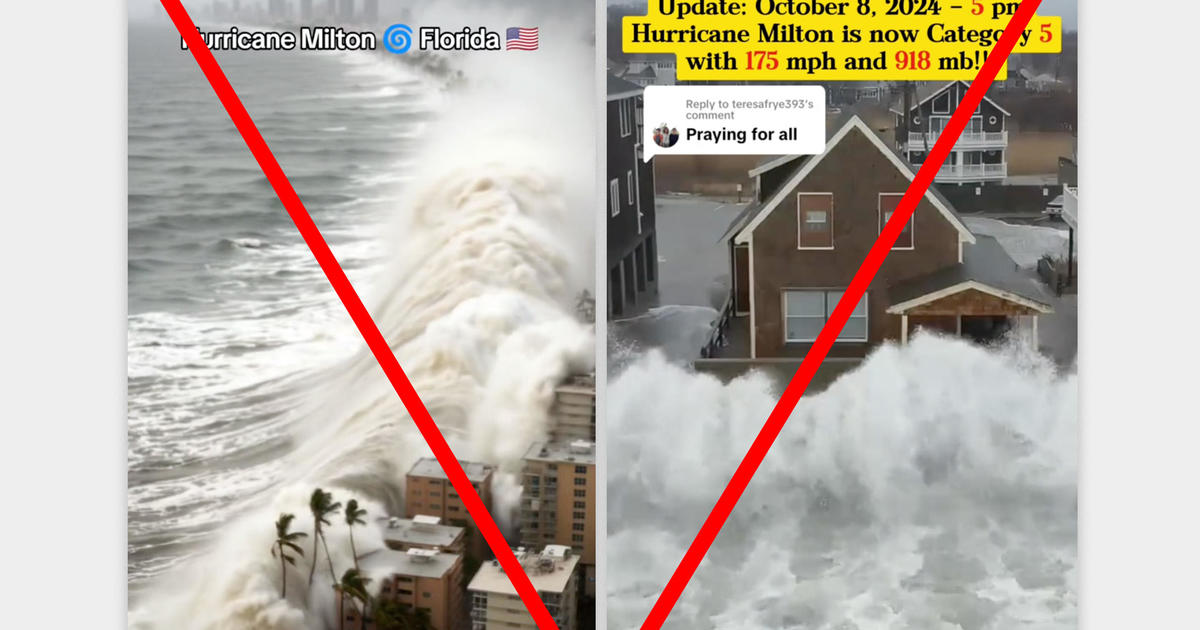Old and fabricated hurricane videos go viral. Here’s how to spot them.

How to spot fake hurricane images
As Hurricane Milton slammed Florida’s west coast, dozens of misleading or AI-generated videos spread on social media, racking up millions of views across platforms. One video, falsely said to show Milton, was actually filmed from a 2021 nor’easter in Massachusetts. Another montage, which had 1.5 million views on X, contained AI-generated footage.

Experts say misleading visuals regularly go viral after major natural disasters, often with the aim of amassing views or spreading false claims. The National Weather Service has previously warned of “false or purposely inaccurate severe weather reports” on social media, featuring photos or video taken from events “that happened months to a few years ago.”
Cayce Myers, a professor of public relations at Virginia Tech, said viral AI-generated images during Hurricane Helene showcase the challenges with AI and social media.
“AI technology is providing greater ability to create realistic images that are deceptive,” Myers said, adding, “The problem is these fake images influence peoples’ perception of reality, and social media fuels the spread of this disinformation.”
How to spot bogus videos online
The CBS News Confirmed team has compiled these tips on how to spot bogus videos that often appear after natural disasters:
- Take a moment to think about the media you are seeing. Does the footage appear to match other photos and videos of the location it was filmed, or are there things that seem out of place? Are there elements that suggest the video has been fabricated, like the unrealistic-looking waves in this AI-generated TikTok video?
- Check for other photos or videos of the same location or scene. What do the other angles show, and do they appear to match? If not, it’s possible that the footage is either from a previous weather event or potentially AI-generated.
Julia Feerrar, an associate professor at Virginia Tech, said search engines are helpful in this instance: “Describing the image and adding the phrase ‘fact check’ to your search is often the fastest way to get more information and debunk misleading content.”
- Check what reputable sources including media outlets and journalists are reporting to see if their reports match the content you have found online. Look for official statements from government officials or content released on their verified social media accounts or websites.
For example, the North Carolina Department of Public Safety published fact checks on AI-generated content and other misinformation that swirled online amid Hurricane Helene.
Keep in mind some of these videos circulating on social media are simply recycling old footage.

Social media policies on weather misinformation
House Democrats from states impacted by hurricanes Helene and Milton wrote a letter on Friday to seven technology companies, including Facebook, TikTok and X. The Congress members said there has been a “surge in misinformation, disinformation, conspiracy theories, and scams that are hindering recovery efforts and exploiting vulnerable individuals and families” in Helene’s aftermath.
When contacted by CBS News, Meta and TikTok said both companies are actively working to remove content that violates their policies.
A TikTok spokesperson said the company is directing people who search for Milton or Helene content on their platform to official videos from FEMA, and added the company works with 19 independent fact-checking organizations worldwide.
Meta shared that the company removes content that violates its Community Standards policies and works with 10 third-party fact-checking organizations in the U.S. to debunk false claims or limit the content’s reach if it’s been rated as false.
A representative for X did not return a request for comment.
Beyond CBS News Confirmed’s tips to spot weather misinformation online, the nonprofit think tank RAND has developed a 17-point checklist with more information on how to avoid spreading false claims or misleading media during natural disasters.








